The Whistlestop Project
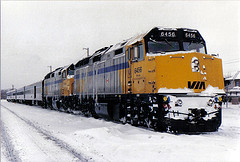
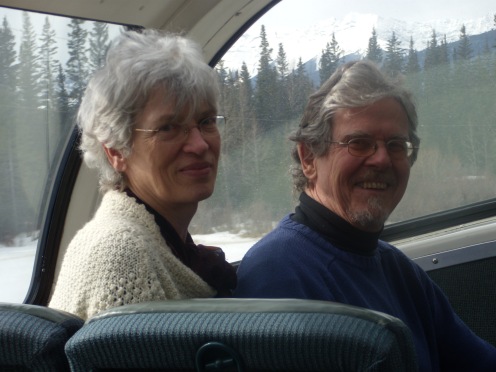
Dorothy Lander and John Graham-Pole did not have time to reflect on each Whistlestop while en route. After all, we had something like 15 whistlestops in 25 days. Moreover, we were preparing for the next whistlestop or downloading our video, audio, and digital camera images onto two external hard drives, in order to clear the memory for the next stop. Upon our return, in between a lot of sleeping, we re-membered so many dazzling encounters with so many wonderful people across this vast land. It struck us that themes of health, healing, and carework emerged at all of the whistlestops, without guiding the conversation in that direction. The following is our thinking about what we could write about women’s healing arts .
The Trans-Canada Whistlestop Project:
Naming and Placing Women as Artists, Educators, and Care Workers
As part of Dorothy Lander’s SSHRC-funded research into the art of popular education across three generations of the women’s movement in Canada, arts-based co-inquirers Dorothy and John Graham-Pole adapt autoethnography, dialogue, women’s travel auto/biographies, feminist genealogies, and métissage (Hasebe-Ludt, Chambers & Leggo, 2009), to exemplify the sustained effect of “naming” artists as health educators, and health care professionals as artists and educators in this context. We braid our different perspectives into a dialogue on our experience of the Whistlestop Project: in March 2009, we traveled coast to coast, from Antigonish, NS to Tofino, BC by rail (plus bus, cab, and ferry) making 15 Whistlestops to meet with rural and urban women’s art and advocacy communities. At each Whistlestop across this vast country, John, a new settler in Canada, took on the technology role of recorder (video, audio, digital camera and logger), while Dorothy facilitated or co-facilitated the group inquiry. Regional differences and the “pedagogy of place” (Ellsworth, 2005) as seen through the stereo lens of the photographer-recorder and the facilitator therefore feature in our dialogue.
The people we met include: poets; writers; dancers; mapmakers; radio and TV hosts; comedians; zine artists; muralists; feminist pornographers; tattoo artists; editors; collagists; photographers; quilters; potters; lace, tatting, and ceramic installation artists; sculptors; knitters; drummers; singers; composers; woodworkers; painters; fashion designers and entrepreneurs; actors and performance artists; playwrights; architects; landscape designers; culinary artists; gardeners; spoken word performers and. . .and. . .and. After Halifax and Antigonish, our Whistlestops were tightly scheduled over 25 days in this order: Montreal; Ottawa; Toronto (2 groups); Plainville, Ontario (with Dorothy’s family and farm community from her childhood); Kemble on the Georgian Bluffs; Winnipeg; Edmonton; Duncan; Nanaimo; Tofino; Victoria: Vancouver. Our conversations ranged from one-on-one to groups of four to twenty. Our conversation with sculptor Barbara Paterson in her studio in Edmonton tracked our journey from the life-sized Moses Coady in front of the Department of Adult Education in Antigonish to the larger than life Famous Five in Ottawa, and onto Emily Carr and her dog, to be installed in September 2009 on the grounds of the Empress Hotel in Victoria. At Barbara’s invitation, we touched the pre-foundry Emily Carr and petted her dog, and even added our own melded pieces of clay to Emily’s underskirts.
Building on Hasebe-Ludt et al.’s (2009) notions of métissage as braided life writing, we also practice autoethnography as an “organic” genre “in a state of perpetual flux, constantly transforming and interpenetrating the permeable borders around them” (p. 17). Our braided dialogue features our reflexive positions – demographic, learned, and textual (Chiseri-Strater & Sunstein, 1997, pp. 57-58). For example, we were newly coupled in 2005 and newly retired from our academic and professional life in 2007, bringing a combined worklife of over 80 years and a 4-year honeymoon to our arts-based writing and research. John left behind a lifetime career as a pediatric oncologist and palliative care doctor in both the UK and the US, and Dorothy a career trajectory in Canada that shifted from service work and the care of young adults (as manager of university residences, food services, cleaning and conferences) to her last 10 working years teaching in the graduate program in adult education at St. Francis Xavier University. Several participants at various Whistlestops were graduates from this practitioner-based, distance education program, who Dorothy advised.
Although the Ottawa Whistlestop was the only purposely focused conversation on art for health, at every Whistlestop health and wellness themes surfaced freely in the many stories of art and popular education, which favour advocacy for women in marginalized populations and communities. The wide-ranging themes of health and social care, both contemporary and historical are listed here in no special order: sexualities, sexual pleasure, sexual violence; reproductive technologies (e.g., tubal ligation); sex workers’ health; missing and murdered women on Highway 16 (highwayoftears.com); ethics and tissue/organ transplantation (e.g., stem cell, placenta); psychiatric survivors, depression, mental health; work-life balance; breast cancer activism; body image, eating disorders; health promotion, e.g., healthy hearts, smoking cessation, addictions; harm reduction re AIDS & substance abuse, scientific temperance education of the Woman’s Christian Temperance Union (WCTU); nutrition, hospitality, local and organic cooking; nursing; midwifery; aging; bereavement, palliative care, end-of-life care; pastoral counseling; homelessness, poverty, illiteracy; Barnardo Homes for children/orphans in Ontario; mothering, parenting, infant mortality; ecological health, organic gardening; Women’s Institutes and pasteurization, E-coli, Walkerton Inquiry; holistic medicine, healing touch; mixed-race issues, residential schools, and. . .and. . .and.
The Ottawa Whistlestop led off with a participatory hop of men and women of all generations and (dis)abilities around the Famous Five Monument on Parliament Hill, guided by Renata Soutter of the multi-ability Propeller Dance Company (propellerdance.com), and accompanied by taiko drummer Jackie Steele and drum and fife musician Mark Rehder, also manager of the Grasshoppa Dance Exchange. When we moved the guided inquiry into the House of Commons committee room 238S, reserved for us through our MP Peter MacKay’s office, several participants raised the imperative of continuing to name today’s marginalized populations as Persons, especially in social justice work (e.g., racism, ageism, sizeism, poverty, homelessness, environmental rights, queer rights, Aboriginal rights, and disabled rights). We name Christopher of the multi-ability Propeller Dance Company (see Figure below) as an exemplary artist of headstands, art-for-health activist and popular educator.

The intergenerational participation at the Ottawa Whistlestop exemplifies the significance of naming within genealogical method, charting the continuities and discontinuities in participatory art for health from the era of the Famous Five (Nellie McClung, Henrietta Muir Edwards, Louise McKinney, Irene Parlby, Emily Murphy) and the 1929 Persons Case up until today. Declaring – naming – Women as Persons is arguably the most famous Canadian feminist exemplar of naming our world in order to change it (Freire, 2002). Our belief that recognizing all human beings as Persons is vital to individual and population health and health care practice, is closely allied to a fundamental principle of the women’s movement: Women’s Rights are Human Rights.
Works Cited:
Chiseri-Strater, E., & Stone Sunstein, B. (1997). FieldWorking: Reading and writing research. Upper Saddle River, NJ: Blair Press.
Ellsworth, E. (2005). Places of learning: Media, architecture, pedagogy. New York: Routledge.
Freire, P. (2002). Pedagogy of the oppressed (30th Anniversary Ed.). New York: Continuum. (Original published in 1972)
Hasebe-Ludt, E., Chambers, C. M., & Leggo, C. (2009). Life writing and literary métissage as an ethos for our times. New York: Peter Lang.
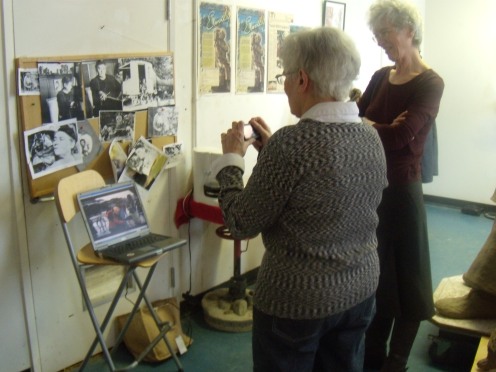
Here Famous Five sculptor Barbara Paterson in her Edmonton Studio on March 22 taking a digital photo of our video footage of the participatory hop and drum around the Famous Five on March 11 for the Ottawa Whistlestop. “Interactive” is the word Barbara uses to express what she hopes to manifest through her art — and clearly her hopes were realized. Look closely at the righthand edge of the picture and the hem of Dorothy’s skirt, and you will see the pre-foundry foot of Emily Carr, which will be transported to the grounds of the Empress Hotel in Victoria, for unveiling in September 2009.
****
Kemble Women’s Institute Whistlestop, March 17, 2009
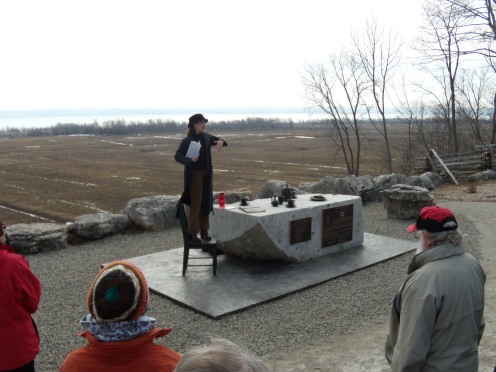
The following is an excerpt of an email from Dorothy to her siblings, who had a particular interest in this Whistlestop, as playwright and actor Leanna Brodie, who read from her play For Home and Country at the Women’s Institute cairn on the Georgian Bluffs, knew our mother as Mrs. Lander, her grade 3 teacher in a 2-room schoolhouse in Bewdley, Ontario.
I know that some of you are eager to hear about my whistlestop on the Georgian Bluffs, at the cairn for the Kemble Women’s Institute, the oldest active WI in the world, as Leanna Brodie, who Mum taught in Grade 3 at Bewdley, now an actor, playwright, and librettist read from her play about the WI, For Home and Country, which played at 4th Line Theatre in Millbrook, which Mum got to see. Leanna said she was sad that Mrs. Lander didn’t get to see her Schoolhouse play. Leanna stood on the sculpted chair to read, saying this is something that no WI member would ever do. There was a whole passage about the WI women learning bee keeping, in which we all had to participate by making buzzing sounds — so I was happy to have the feminine imagery of bees and beekeeping repeat [our cousin] Trevor’s reminder about who’s in charge of the hive. A new learning about the WI and their signature sunhats of blue — apparently because of the tractor of the time (Ford) was blue. I had a sudden flash about teasing about popcorn tractors in our family, thinking that our family, at least Dad to Uncle Frank and Uncle Earl, would have been promoting orange hats [Allis-Chalmers] rather than blue ones! Leanna and I did not have much time to talk about Mum and Aunt Flo as her teachers but we told the whole group at Kemble about our connection, and Leanna told us all that she had her first acting gig as Little Red Riding Hood with Mrs. Barrett [our Aunt Flo.] Like most of our childhood memories, she couldn’t remember specific episodes around my mother as her teacher, but said “she was just so kind.” She was sad when she retired because she did not “get on” with the next teacher. She said it wasn’t easy being a Jewish kid in Bewdley and she did remember that Mum made sure that even the “oddball” was included. She had a funny story about her mother meeting her new teacher at Bewdley and expressing relief that Mrs. Barrett had moved from Plainville — lots of folks thought Mrs. Barrett and Mrs. Lander looked alike though I couldn’t see it.
In my first contact with Leanna, inviting her to be part of this project, I recalled my mother’s tales about Leanna, who was such a delight. In particular, I remember my mother telling us that the performances in the Christmas Concert that year featured Leanna lighting the menorah and telling her Grade 3 classmates about Hanukkah. Leanna responded that she had no recollection of this but that is sounded like something she “would do.” Reflecting on this conversation made me wonder about Jewish feminism, and I discovered an internet article — http://jewishminnesota.org/page.aspx?id=35189 — stating that Jewish feminist ritual objects are growing in popularity, e.g., the menorah and Miriam’s cups. For more on feminist rituals, such as serving cheese for Hanukkah (Judith features here), take a look at http://users.erols.com/saftyrma/chanukah.htm and Sandra Butler’s work with the Women in Black www.imagesofdivinity.org/pdf/07-18-05_BMC/Butler_6-18-05.pdf
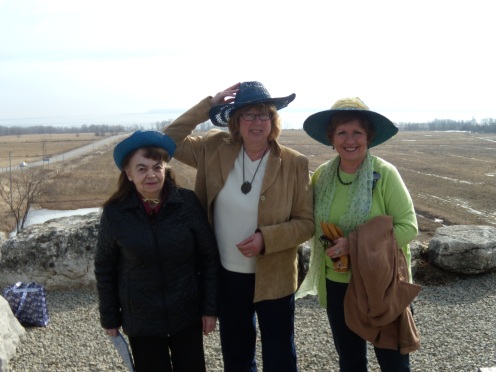
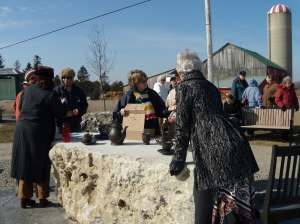 For the Kemble WI Whistlestop, we stayed in Owen Sound with my longtime friend Harriett Grace, from university days in the 60s at Queens. Harriett was also my on-the-ground point person for all the arrangements with the Women’s Institute members in Kemble, including our small inquiry group meeting at Cory McQuigge’s home, just a stone’s throw from the cairn. Cory is in the middle of the blue-hatted threesome above. In the image of the cairn in which Leanna and I have our backs to the camera, Harriett is in the centre wearing the Hudson’s Bay scarf and doing the unnoticed “service” of readying Leanna’s books, both her plays and fiction, for sale and book signing. The barn, silo and manure pile as backdrop to this picture is the perfect reminder that the Women’s Institute is largely a rural women’s movement, modelled on the Farmer’s Institute. Harriett reported that a photo of Leanna Brodie’s reading at the WI Cairn made it to page 3 of the Owen Sound Sun Times on March 18, 2009. She supposed that if our event hadn’t been St. Patrick’s Day, it would probably have been on page 1. Here is a regional perspective on Leanna’s reading that you would pick up on only if you knew the people in the audience, as Harriett and her husband Doug Grace did. Murray McQuigge, Cory’s husband, was at the gathering at the cairn, and significantly, he called out, when Leanna asked who could identify some of the contributions of the WI — “pasteurization.” Leanna re-enacted the role of Adelaide Hoodless and the organizing moments of the WI in Stoney Creek, Ontario in 1897. Adelaide’s infant son died from drinking impure milk and so it was that she began her advocacy for domestic science education among rural women. The connection to the 21st century is clear when you know that Murray McQuigge was the medical officer of health, who is credited with breaking the news about the E-coli infection (Escherichia coli 0157:H7 ) in Walkerton’s water supply. Like Kemble, Walkerton is in Grey-Bruce County. Doug was Murray McQuigge’s lawyer in the Walkerton Inquiry, and if any of you watched this developing on TV news, Doug’s often emotional arguments were worthy of repeated sound (and image) bites. Perhaps reminiscent of Leanna as Adelaide Hoodless, saying: ” Have you ever watched a child die? I have. Does my question shock you? It is far less shocking than the reality. When I add that this was my child; that his death was my fault; that he died from drinking tainted milk; and that such deaths are easily preventd by pasteurization. … To those who scoff at my crusade for the teaching of domestic science, I say this: if we knew that ninety percent of all boys would take up the exact same occupation, surely our schools would see fit to prepare them for it” (Brodie, 2004, p. 20)
For the Kemble WI Whistlestop, we stayed in Owen Sound with my longtime friend Harriett Grace, from university days in the 60s at Queens. Harriett was also my on-the-ground point person for all the arrangements with the Women’s Institute members in Kemble, including our small inquiry group meeting at Cory McQuigge’s home, just a stone’s throw from the cairn. Cory is in the middle of the blue-hatted threesome above. In the image of the cairn in which Leanna and I have our backs to the camera, Harriett is in the centre wearing the Hudson’s Bay scarf and doing the unnoticed “service” of readying Leanna’s books, both her plays and fiction, for sale and book signing. The barn, silo and manure pile as backdrop to this picture is the perfect reminder that the Women’s Institute is largely a rural women’s movement, modelled on the Farmer’s Institute. Harriett reported that a photo of Leanna Brodie’s reading at the WI Cairn made it to page 3 of the Owen Sound Sun Times on March 18, 2009. She supposed that if our event hadn’t been St. Patrick’s Day, it would probably have been on page 1. Here is a regional perspective on Leanna’s reading that you would pick up on only if you knew the people in the audience, as Harriett and her husband Doug Grace did. Murray McQuigge, Cory’s husband, was at the gathering at the cairn, and significantly, he called out, when Leanna asked who could identify some of the contributions of the WI — “pasteurization.” Leanna re-enacted the role of Adelaide Hoodless and the organizing moments of the WI in Stoney Creek, Ontario in 1897. Adelaide’s infant son died from drinking impure milk and so it was that she began her advocacy for domestic science education among rural women. The connection to the 21st century is clear when you know that Murray McQuigge was the medical officer of health, who is credited with breaking the news about the E-coli infection (Escherichia coli 0157:H7 ) in Walkerton’s water supply. Like Kemble, Walkerton is in Grey-Bruce County. Doug was Murray McQuigge’s lawyer in the Walkerton Inquiry, and if any of you watched this developing on TV news, Doug’s often emotional arguments were worthy of repeated sound (and image) bites. Perhaps reminiscent of Leanna as Adelaide Hoodless, saying: ” Have you ever watched a child die? I have. Does my question shock you? It is far less shocking than the reality. When I add that this was my child; that his death was my fault; that he died from drinking tainted milk; and that such deaths are easily preventd by pasteurization. … To those who scoff at my crusade for the teaching of domestic science, I say this: if we knew that ninety percent of all boys would take up the exact same occupation, surely our schools would see fit to prepare them for it” (Brodie, 2004, p. 20)
Brodie, Leanna (2004). For home and country. Vancouver: Talon Books.
***
Tofino on Vancouver Island was the most westerly point on our Whistlestop Journey. Anita Sinner joined us on all four whistlestops on Vancouver Island, including Victoria, Duncan, Nanaimo, and Tofino. Anita shaped an audio video montage of the Tofino Whistlestop for You Tube, which is linked here: http://www.youtube.com/watch?v=0cgK8RwYtJc
We had cooks, collagists, dancers, mosaic and mural makers, poets, painters and photographers at the Tofino Whistlestop. Here is a still of Therese demonstrating the fire of flamenco.
Dorothy and Anita wrote a video essay for the journal Visual Culture and Gender, which included all of our Whistlestops on Vancouver Island: Victoria, Duncan, Nanaimo, Qualicum Beach and Tofino.
Lander, Dorothy A., & Sinner, Anita E. (2010). Naming ourselves as popular educators: An appreciative inquiry into Canadian west coast women artists’ identity (Video essay). Visual Culture and Gender, 5, 35-48. Available from http://www.emitto.net/visualculturegender
 Therese Bouchard, flamenco dancer, Tofino, British Columbia
Therese Bouchard, flamenco dancer, Tofino, British Columbia
To make our Whistlestop Tour coast to coast, we visited Newfoundland later in the year. Our St. John’s host was Dorothy’s longtime university Jewish friend from Queen’s, Riva McKee. The Irish pub in their basement is an expression of the political and social values of her Belfast husband Ed. Novelist Beatrice Morgan and folklorist Anne Hart are shown here. Beatrice Morgan’s first novel, Random Passage, is an archetypal account of early outport settlement. Anne Hart, biographer of Mina Benson Hubbard, had met Dorothy’s mother in the family home on Rice Lake, Ontario, to learn more about Mina’s early history. Dorothy’s grandmother, Agnes Benson and Mina were first cousins and fast friends. In the second photo, Riva is showing the talents from her tap dance class. Riva is out front.

Beatrice Morgan and Anne Hart, Newfoundland Whistlestop
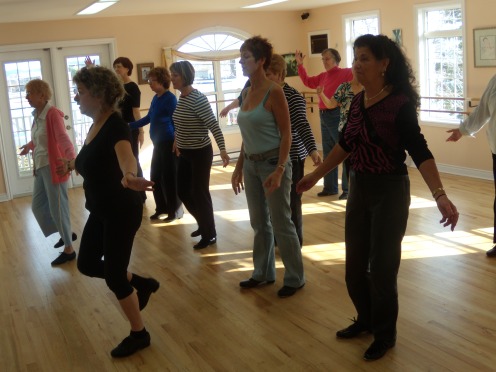
Riva McKee at her weekly tap dance class
Dorothy and John met separately with realist painter, Mary Pratt, in her St. John’s home, in which red is the accent colour. Note the corner of her red sink in the photo where she is serving us tea and gingerbread. She showed some publications with her paintings, contrasting the domestic focus on jellies, casseroles, and pristine clotheslines to the “vicious reality” of slaughtered animals.
In the 1994 article in Canadian Art, Robin Laurence put it this way.
One aspect of this vicious reality is the recurring image of sacrifice: bleeding fish, burning paper, eviscerated chickens, broken eggshells, a moose skinned, quartered and hanging by ropes against an expanse of frozen white. An almost totemic sense of appeasement attends these images of trussed, gutted and sectioned flesh, as if Pratt were honouring the spirits of the creatures that have relinquished their lives to human consumption. But evocations are multiple, the Biblical made contemporary with concerns over political and environmental issues. The fish, for instance. In Pratt’s work, fish are archetypes of life and abundance, of fertility and resurrection. But they are also markers of economic and cultural identity, and gauges of environmental degradation. “Fish are the beginnings of life for us,” says Pratt—meaning all of us. “It’s terrible to think that they are in trouble.”
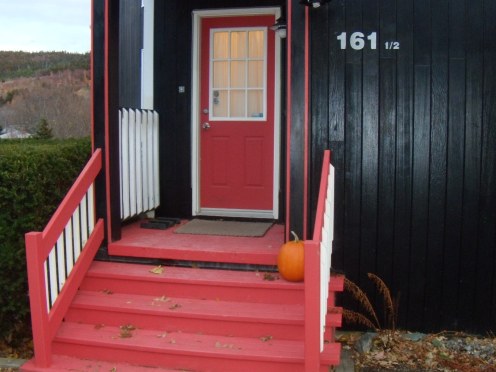
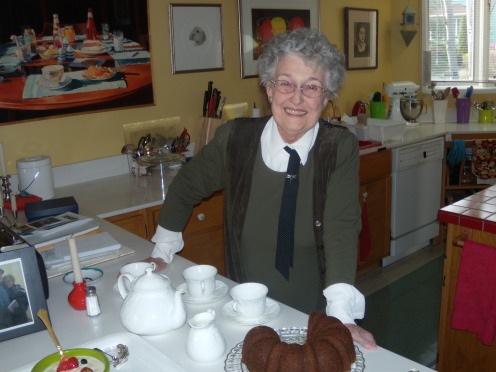
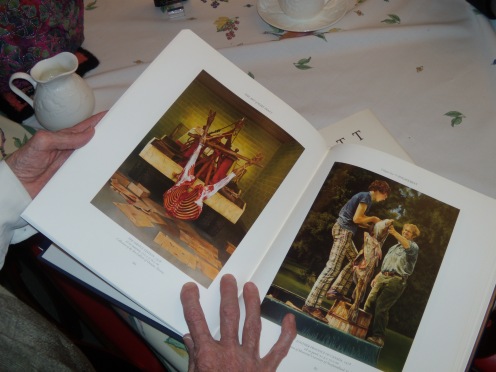
***

The Famous Five have been removed from the Canadian $50 bill. It will be harder to remove the larger than life sculptures from Parliament Hill.
LikeLike
Rachel Maines of Cornell University is a researcher into the history of textiles (as well as The Technology of Orgasm — see posting on Hysteria). The knitting work of the Women’s Institutes during WW! would be of interest to you. She presented on the topic of “Socks at War: Trenchfoot Casualties in the American Forces in World War II.” The British military
had learned the importance of dry socks during WWI. To help
American soldiers avoid contracting the condition, the US military
requisitioned commercially made socks and filled in the supply gaps
with hand knitted socks produced by women from the home front.
LikeLiked by 1 person